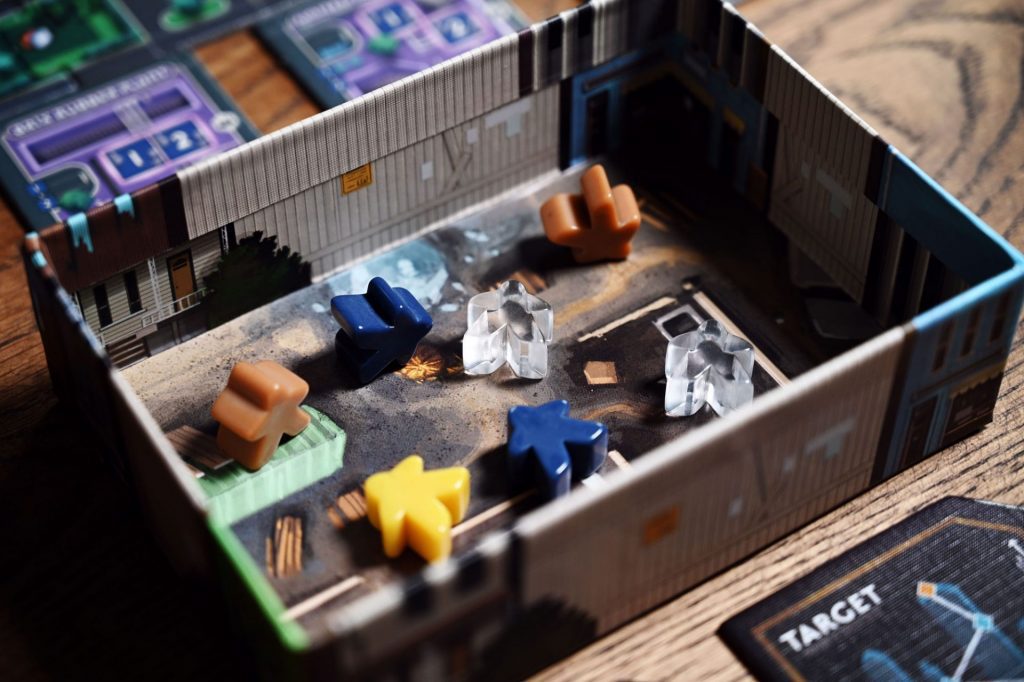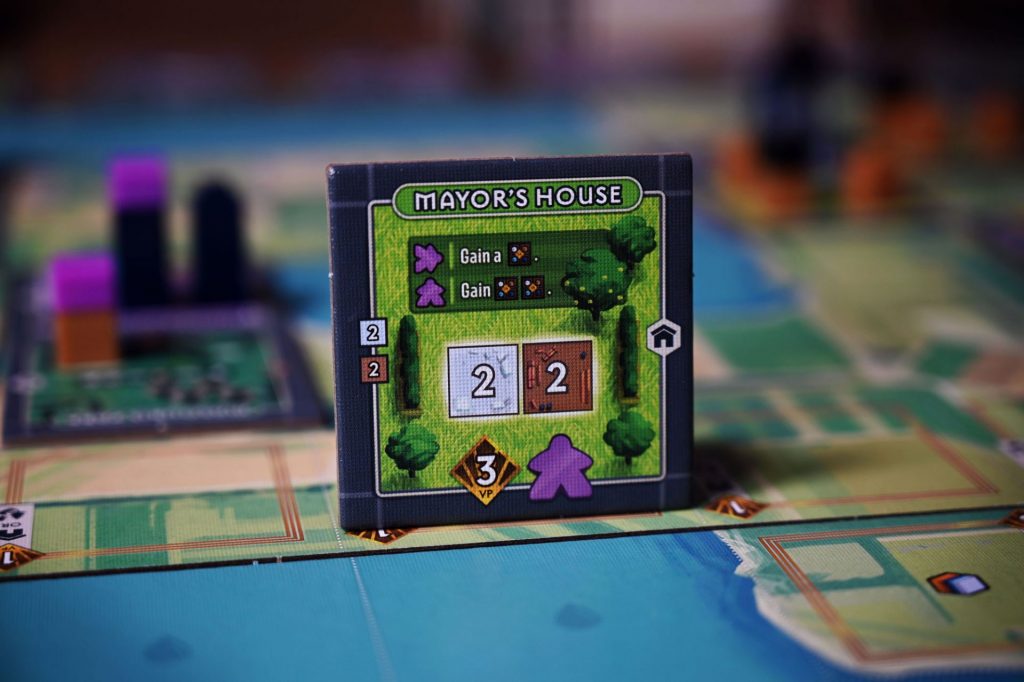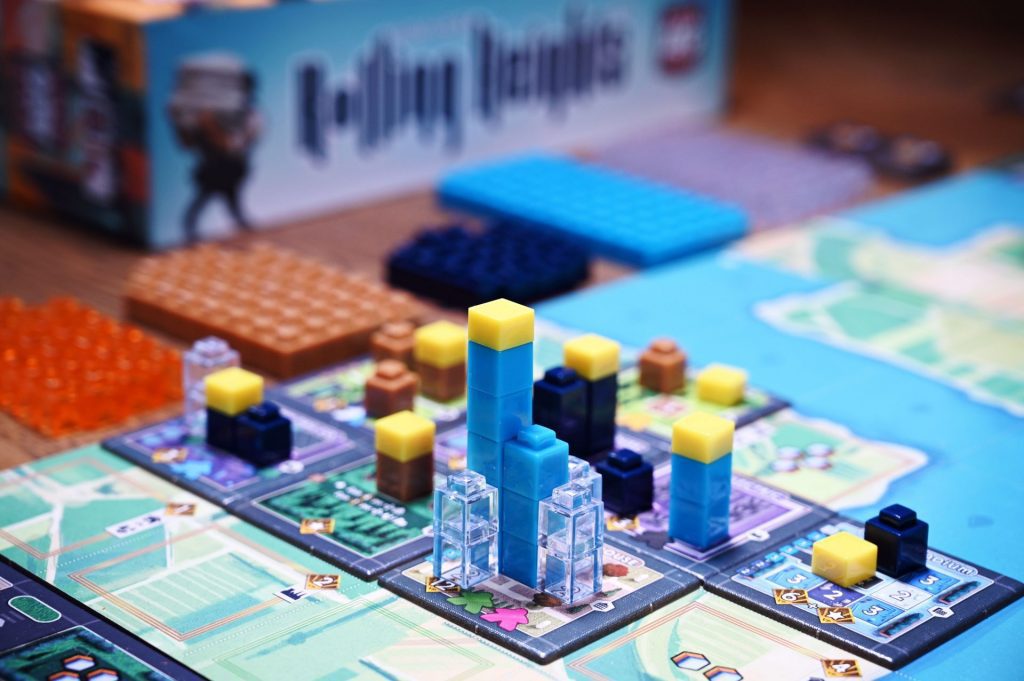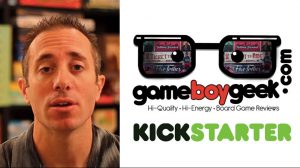Skyscraper.
The very notion is both thrilling, and terrifying (depending on whether you’re at the bottom or the top). A building whose height makes wind a more important factor than earthquakes or weight. By the early 1900s cities like New York and Chicago were experiencing a boom in construction; not only of skyscrapers, but of buildings of all types. This expansion was fueled by improved technology, materials, and lots of cash.

Rolling Heights is the newest game from AEG and designer extraordinaire John D. Clair. In this game you’ll be riding the wave of growth during the early 20th century. Players act as real estate moguls, trying to build the city of the future. Pick the best locations, construct bigger and better buildings, grow your workforce, and hope to come out on top when the dust settles.
Come along with me as we explore this new city together.

Rolling Heights Overview
Rolling Heights is a modular, tile-laying, city building, “meeple rolling” game for 1-4 players. After arranging the 6 double-sided “city boards” that compose the play area, and laying all the components you can begin play. Over the course of a number of rounds you will claim building tiles and place them onto the board where they wait to be constructed. These tiles each have unique names and give you points, more workers, special abilities, and in some cases end-game scoring opportunities. After the end game conditions are met, the player with the most points is the winner.
Whew, could that be any more vague? Now that you’ve got at least an idea of the blueprint of the game, let’s take a look at just why they call it Rolling Heights.
Workers Unite!
At the heart of the game are your workers, wonderful dense plastic meeples, in a rainbow of colors. These workers are the engine that you’ll use to accomplish your plans and they come in two broad categories: resource workers (brown, dark blue, bright blue, and clear), and ability workers (gold, pink, green, and black). You start the game with a box and four workers – two brown and two dark blue. Brown gives you wood resources, while dark blue gives you concrete. Just how do they do that you ask?
You roll them – just like the game says. Take your workers, shake them in your hand and toss them into the box. Each worker will end up in one of three main orientations: laying flat, standing on their edge, and standing on their feet. Flat meeples are tired and provide no benefit, and in case if too many of your workers are laying flat it means your work force has gone on strike because you’re overworking them (more on that later). As you might guess, edge and upright meeples provide different benefits based on their type. An edge “resource” worker will give you 1 resource of that type, while an upright worker will give you 2.

After you roll your workers pull out any that are standing upright or on their sides and keep rolling until at least half your meeples are out of the box. At that point you can choose to stop and get to work; or you can push your luck and keep rolling. If you ever roll and have all flat workers, then your team goes on strike and you lose half the workers you’ve already pulled out of the box.
Building Tiles
After you’ve finished rolling, use the worker for their ability and move into the second phase of your turn. Next to the board are two rows of building tiles, the cheaper but less desirable Level 1 tiles and the more expensive Level 2 tiles. Tiles on one end of the rows are free to select, while tiles on the opposite end must be paid for up front. After selecting your tile, you place it on the board next to an existing tile that you own, along with one of your markers indicating that you own that tile. During game setup each player will place a tile for free which gives you a basis for expanding out into the rest of the city. Some spaces on the board provide immediate points, while other spaces on the board have “zoning requirements” that dictate the sorts of tiles which can be placed there.
Now might be a good time to examine a building tile up close. Each building tile has a unique name, a “type” (residential, civic, parks, etc.), and a diagram indicating what materials (and how many) must be used to complete construction. Building tiles additionally give you points, either a fixed number or based on some condition. Finally, completed tiles will allow you to grow your workforce by the number of meeples indicated at the bottom of the tile.

Higher & Higher
All of the resource cubes (wood, concrete, steel, and glass) have an inset in the bottom which allows them to be stacked, which is great because it’s time to build upwards. Divvy up the building materials you collected during the roll phase amongst your buildings. Make sure you don’t have any left over because any unused building materials go back to the general supply. If you complete a building you cap it with your player marker and collect your earnings. Points are earned immediately, whereas new workers can be used on your next turn.

Community (no, not the TV show)
Rolling meeples and constructing buildings isn’t the whole game. As you expand out from your starting point you’ll inevitably run into other players’ buildings. And this is where things start to get really interesting. Remember when I said you had to place new tiles next to existing tiles that you owned? That’s not quite accurate. You can pay resources to skip over empty squares, at the cost of 1 resource per, in order to reach spaces that might be a bit more choice, fit a specific zoning requirement, or to meet some end game condition.
Rolling Heights has the notion of neighborhoods, columns, and rows. A single 1 of the 6 city boards is a neighborhood, a column is every building in that specific column, and rows are…well, you guessed it. At the beginning of the game each player is given 2 private end game scoring options of which you can score 1. In addition there are 3 public end game scoring options that everyone can fulfill. Generally those have to do with groups of buildings, building types, or your own buildings in a column of row. If you’ve played Space Base or Ecos: First Continent (also from John D. Clair) then you’re likely familiar with the way his mind works. It’s always points within points, and scoring options galore.

All Good Things Come to an End
You’ll continue taking rounds throughout the course of the game until one resource is completely out. Then play will wrap up and players will tally their scores. Because you’ve been earning points throughout the game, the only thing left will be the end game scoring. Pick your hidden tile and flip it over, discarding the other one (unless you have a special ability that allows you to keep both). Every player counts up the points they earn from the public scoring options and the winner is announced with great pomp and circumstance.
Final Thoughts about Rolling Heights
I’ve mentioned before how much I enjoy games from AEG. Point Salad, Whirling Witchcraft, Cascadia, Automobiles; their games speak to me as a gamer. Not too heavy, not too light…well designed, great components, well thought out gameplay, and most of all fun. Rolling Heights definitely has a lot of those things going for it, but also has some flaws which I’ll dig into here.
One thing you might have noticed throughout this review is the artwork, masterfully illustrated by Kwanchai Moriya. His art style is instantly recognizable which helps to make any game he’s a part of really stand out from the crowd. The graphic design work by Stephanie Gustafsson contributes to the overall appeal with crystal clear iconography and layout.

However while the icons themselves were easy to discern, there were some issues with the sizing. The tiles you’ll be placing will be in different areas of the board, in some cases 2 or more feet from a player. And given that some scoring depends on placing your tile next to others of a certain type, you really need to be able to see them. The publisher has indicated they’ll address the sizing prior to print.
You might also notice some minor color issues in meeples. There’s a glossy dark blue meeple alongside a glossy black meeple – instant difficulty. This is another thing that AEG intends to fix before print.
One of the biggest issues that plagued our gameplay was clarity around scoring conditions, and game length. Because you’ve got 3 certain scoring options and 2 potential options (your hidden goals), there’s a lot to think about. There are many points revolving around where you place your tiles. This causes two problems. Without a clearer understanding of the scoring our turns took longer since we were forced to debate the meanings. Additional time was taken because players had to examine all of the tiles on offer to determine which was the best one for them at the time. Thankfully players can perform the initial meeple rolling and selection while waiting for the players before them. But play can’t continue until the player before you has placed their tile, etc.
And all of this led to my biggest gripe about the game; it’s length. The box advertises 45-60 minutes, but there’s just no way most people will finish a game of Rolling Heights in that time. Our games generally took nearly 2 hours to complete. Admittedly we had rules discussions and were just learning the game, but even then I’d say the time on the box is pretty far off the mark. Because this is not yet released AEG will have the chance to adjust, but given some of John D. Clair’s other games I’d wager they’ll go the route of updating the time rather than tweaking the game itself for length.
Rolling Heights has some great things going for it, with a blend of gameplay that I haven’t seen before. Some of our favorite parts of the game were rolling those meeples. They’re made of a high impact plastic like the pieces in Reef, and are definitely candidates for being irresistibly touchable. If you’ve ever played the game Pass the Pigs, you’ll know how to roll these meeples. Sadly Rolling Heights doesn’t differentiate between a meeple on its head vs one on its side, because that would be awesome. The way each color of meeple benefits the player seems to work really well together. Green meeples allow you upgrade any one meeple from laying to working hard which can have a dramatic impact. Purple meeples have the chance to double the resources you collect for meeples of a specific color, while gold meeples just give you straight up points.
But perhaps the most impressive thing about Rolling Heights is something we at Meeple Mountain like to call “Builder’s Satisfaction”. It’s the feeling you get when you step back from the game area when all is said and done and marvel at what you’ve built. Games like Cascadia, Medina, Castles of Mad King Ludwig, and Rolling Heights all leave players with something almost wholly unique, a never again seen combination of colors, shapes, and positions. And whether you win or lose, you know you’ve spent your time having fun with your friends and building something magical – and you got to play a game at the same time.













I really love your reviews. Thorough, honest, and more useful than most out there. Thanks!
Thank you RJ, I appreciate your kind words. We always want to present a game honestly, highlighting the good and the bad things in equal measure. In fact we were just having a discussion about this recently in our group chat. It doesn’t serve the consumer (you possibly) if we only ever talk about the good things. So I’m glad you liked it.
Great read! I got a nice overview on both how to play this game, as well as your thoughts on it – which is exactly what I was looking for here!
I’m glad they are willing to update the game before release to address some of your concerns. I wonder if more clear instructions would have helped the rules discussions which caused the time issues you spoke about?
Thanks for your kind words Nathan, appreciated. Rolling Heights is a really fun and interesting game. I’ve played lots of games from AEG and have talked to their staff in person. I have every confidence they’ll fix any actual problems with Rolling Heights.